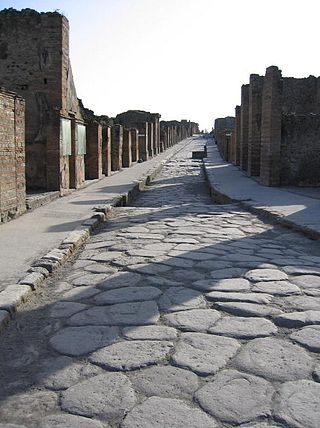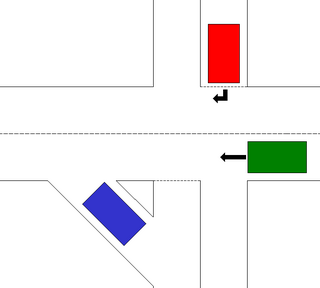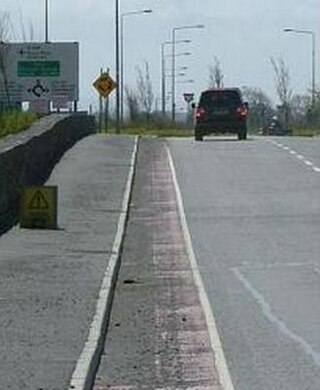Related Research Articles

A sidewalk, pavement, footpath in Australia, India, New Zealand and Ireland, or footway is a path along the side of a road. Usually constructed of concrete, pavers, brick, stone, or asphalt, it is designed for pedestrians. A sidewalk is normally higher than the roadway, and separated from it by a kerb. There may also be a planted strip between the sidewalk and the roadway and between the roadway and the adjacent land.

Speed limits on road traffic, as used in most countries, set the legal maximum speed at which vehicles may travel on a given stretch of road. Speed limits are generally indicated on a traffic sign reflecting the maximum permitted speed, expressed as kilometres per hour (km/h) or miles per hour (mph) or both. Speed limits are commonly set by the legislative bodies of national or provincial governments and enforced by national or regional police and judicial authorities. Speed limits may also be variable, or in some places nonexistent, such as on most of the Autobahnen in Germany.

A pedestrian is a person traveling on foot, whether walking or running. In modern times, the term usually refers to someone walking on a road or pavement, but this was not the case historically. Pedestrians may also be wheelchair users or other disabled people who use mobility aids.

Automotive safety is the study and practice of automotive design, construction, equipment and regulation to minimize the occurrence and consequences of traffic collisions involving motor vehicles. Road traffic safety more broadly includes roadway design.

Road traffic safety refers to the methods and measures used to prevent road users from being killed or seriously injured. Typical road users include pedestrians, cyclists, motorists, vehicle passengers, and passengers of on-road public transport.
Traffic psychology is a discipline of psychology that studies the relationship between psychological processes and the behavior of road users. In general, traffic psychology aims to apply theoretical aspects of psychology in order to improve traffic mobility by helping to develop and apply crash countermeasures, as well as by guiding desired behaviors through education and the motivation of road users.

Rumble strips are a traffic calming feature to alert inattentive drivers of potential danger, by causing a tactile fuzzy vibration and audible rumbling transmitted through the wheels into the vehicle interior. A rumble strip is applied along the direction of travel following an edgeline or centerline, to alert drivers when they drift from their lane. Rumble strips may also be installed in a series across the direction of travel, to warn drivers of a stop or slowdown ahead, or of an approaching danger spot.

The National Traffic and Motor Vehicle Safety Act was enacted in the United States in 1966 to empower the federal government to set and administer new safety standards for motor vehicles and road traffic safety. The Act was the first mandatory federal safety standards for motor vehicles. The Act created the National Highway Safety Bureau. The Act was one of a number of initiatives by the government in response to increasing number of cars and associated fatalities and injuries on the road following a period when the number of people killed on the road had increased 6-fold and the number of vehicles was up 11-fold since 1925. The reduction of the rate of death attributable to motor-vehicle crashes in the United States represents the successful public health response to a great technologic advance of the 20th century—the motorization of the United States.

Vehicular cycling is the practice of riding bicycles on roads in a manner that is in accordance with the principles for driving in traffic, and in a way that places responsibility for safety on the individual.

Transportation safety in the United States encompasses safety of transportation in the United States, including automobile crashes, airplane crashes, rail crashes, and other mass transit incidents, although the most fatalities are generated by road incidents annually killing 32,479 people in 2011 to over 42,000 people in 2022. The number of deaths per passenger-mile on commercial airlines in the United States between 2000 and 2010 was about 0.2 deaths per 10 billion passenger-miles. For driving, the rate was 150 per 10 billion vehicle-miles: 750 times higher per mile than for flying in a commercial airplane. For a person who drives a million miles in a lifetime this amounts to a 1.5% chance of death.
Sleep-deprived driving is the operation of a motor vehicle while being cognitively impaired by a lack of sleep. Sleep deprivation is a major cause of motor vehicle accidents, and it can impair the human brain as much as inebriation can. According to a 1998 survey, 23% of adults have fallen asleep while driving. According to the United States Department of Transportation, twice as many male drivers than female drivers admit to have fallen asleep while driving.

Wrong-way driving (WWD), also known as contraflow driving, is the act of driving a motor vehicle against the direction of traffic. It can occur on either one- or two-way roads, as well as in parking lots and parking garages, and may be due to driver inattention or impairment, or because of insufficient or confusing road markings or signage, or a driver from a right-hand traffic country being unaccustomed to driving in a left-hand traffic country, and vice versa. People intentionally drive in the wrong direction because they missed an exit, for thrill-seeking, or as a shortcut.

86 percent of people in the United States use private automobiles as their primary form of transportation to their workplace.

In road design, a slip lane is a road at a junction that allows road users to change roads without actually entering an intersection. Slip lanes are "helpful ...for intersections designed for large buses or trucks to physically make a turn in the space allotted, or where the right turn is sharper than a 90 degree turn." Slip lanes may reduce congestion and "t-bone" motor vehicle collisions, but they increase the risk for pedestrians, cyclists and horse riders who cross the slip lane.

A traffic collision, also known as a motor vehicle collision, or car crash, occurs when a vehicle collides with another vehicle, pedestrian, animal, road debris, or other moving or stationary obstruction, such as a tree, pole or building. Traffic collisions often result in injury, disability, death, and property damage as well as financial costs to both society and the individuals involved. Road transport is statistically the most dangerous situation people deal with on a daily basis, but casualty figures from such incidents attract less media attention than other, less frequent types of tragedy. The commonly used term car accident is increasingly falling out of favor with many government departments and organizations, with the Associated Press style guide recommending caution before using the term. Some collisions are intentional vehicle-ramming attacks, staged crashes, vehicular homicide or vehicular suicide.

A roadway departure is a type of incident that occurs when a vehicle leaves the roadway. Such incidents can lead to a single-vehicle collision.

The geometric design of roads is the branch of highway engineering concerned with the positioning of the physical elements of the roadway according to standards and constraints. The basic objectives in geometric design are to optimize efficiency and safety while minimizing cost and environmental damage. Geometric design also affects an emerging fifth objective called "livability", which is defined as designing roads to foster broader community goals, including providing access to employment, schools, businesses and residences, accommodate a range of travel modes such as walking, bicycling, transit, and automobiles, and minimizing fuel use, emissions and environmental damage.

Road debris, a form of road hazard, is debris on or off a road. Road debris includes substances, materials, and objects that are foreign to the normal roadway environment. Debris may be produced by vehicular or non-vehicular sources, but in all cases it is considered litter, a form of solid waste. Debris may tend to collect in areas where vehicles do not drive, such as on the edges (shoulder), around traffic islands, and junctions.

Distracted driving is the act of driving while engaging in other activities which distract the driver's attention away from the road. Distractions are shown to compromise the safety of the driver, passengers, pedestrians, and people in other vehicles.

People who are driving as part of their work duties are an important road user category. First, workers themselves are at risk of road traffic injury. Contributing factors include fatigue and long work hours, delivery pressures, distractions from mobile phones and other devices, lack of training to operate the assigned vehicle, vehicle defects, use of prescription and non-prescription medications, medical conditions, and poor journey planning. Death, disability, or injury of a family wage earner due to road traffic injury, in addition to causing emotional pain and suffering, creates economic hardship for the injured worker and family members that may persist well beyond the event itself.
References
- ↑ "Traffic Safety Center Newsletter, UC Berkeley, Fall-Winter 2008, Vol. 5 No. 1" (PDF). Archived from the original (PDF) on 2011-07-20. Retrieved 2011-05-06.
- ↑ Mohn, Tanya. "Americans Are Driving More, And That Means More Risk". Forbes. Retrieved 2021-01-09.
- ↑ FHWA Guidance Memo on Proven Crash Countermeasures, July 2008